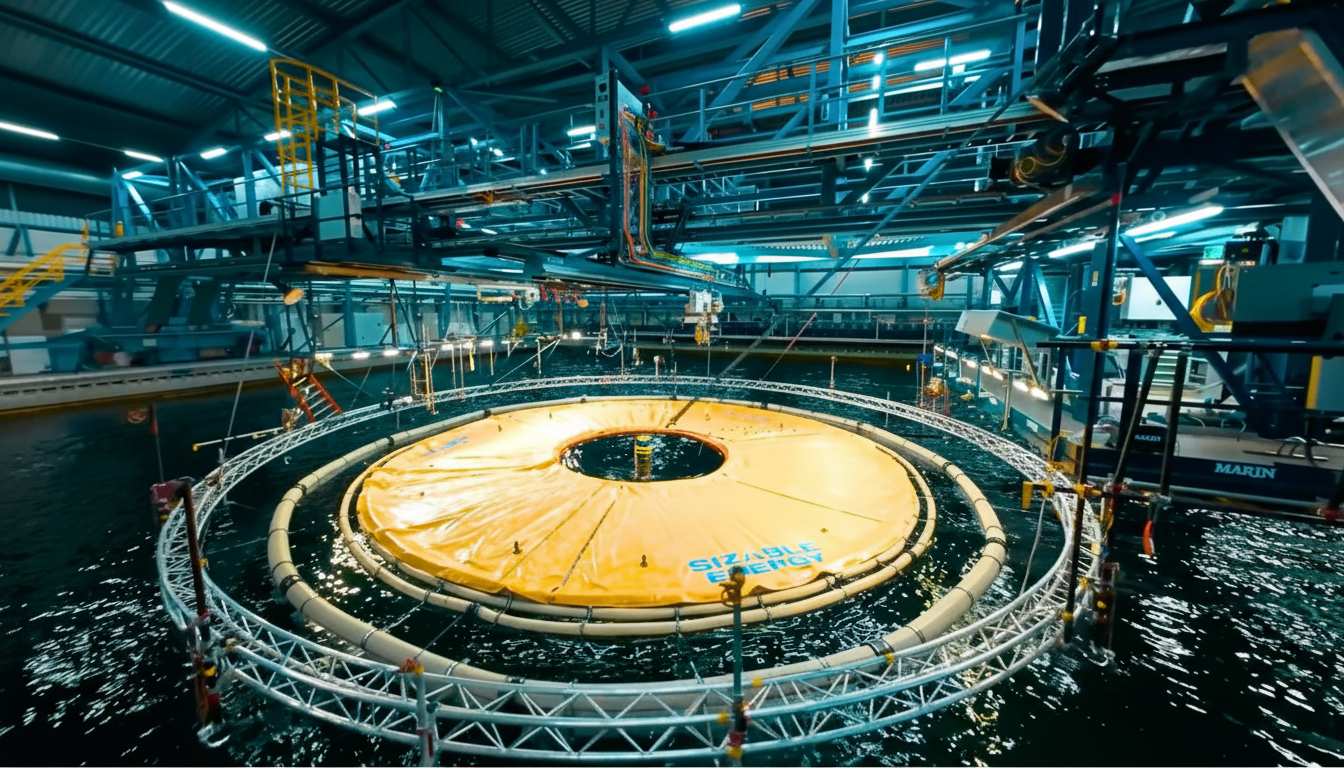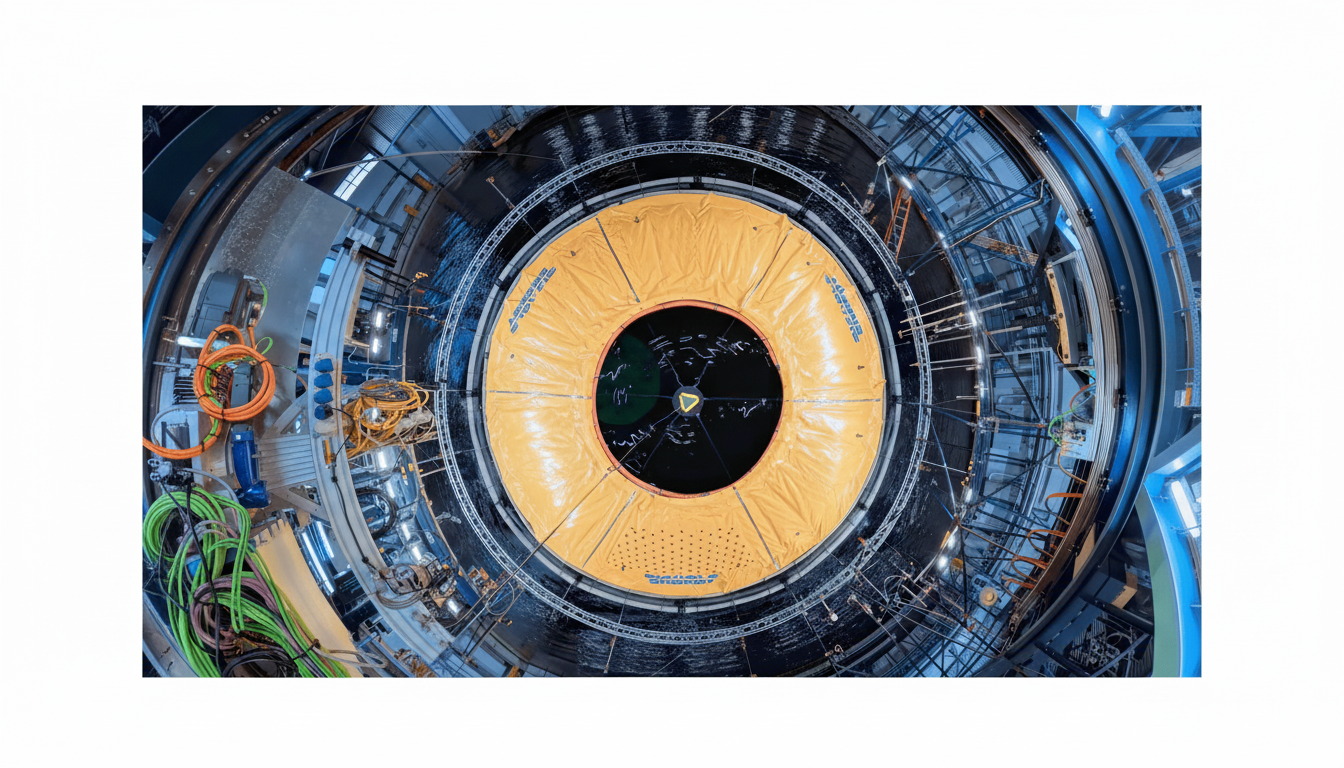A small team at Sizable Energy wants to make the ocean into a big battery, the technical name for which is a half-cell redox system. Their bet is an easy idea to describe and a very difficult one to put into effect: move tested pumped-hydro techniques out into the ocean, substituting brine for mountain reservoirs, scaled up where deep water is abundant but land is scarce.
The goal is long-duration storage that can firm up renewables and stabilize grids. The International Energy Agency considers pumped hydro to be the workhorse of a current storage fleet that contains about 8,500 gigawatt-hours of such capacity around the world — but geography constrains where new facilities can go on land. Sizable wants to bypass that limitation by going subsea.

A New Spin on Pumped Hydro at Sea Using Dense Brine
Unlike a dam and valley, Sizable’s design features two movable reservoirs separated by a flexible pipe in between and a train of water turbines inside. One tank is floating on the surface; the other rests at the bottom of the sea. Pumps, when electricity is cheap, pump ultra-salty water up. And when the grid requires power, those valves open and the heavy brine sinks down a pipe, setting turbines whirring to generate electricity.
The physics of it, says co-founder Manuele Aufiero, is like lifting a “dissolved weight.” The mass is not a solid block; it’s salt in solution. The higher the brine density and the more water in the column, the more energy per cycle can be stored in the system.
Why Salt Concentration and Depth Matter So Much
Offshore, head — the amount of vertical depth that water falls — is a big advantage. At 500 meters or so, the pressure differential is significant without any terrestrial digging. Sizable’s concept puts a turbine roughly every 100 meters of pipe; at full scale, each produces on the order of 6 to 7 megawatts, and multiple turbines are laid out across multiple lines and reservoirs at a site.
Salinity adds another lever. Brine more dense than seawater falls with greater force, increasing energy per unit volume. The brine stays contained, the company says, because its reservoirs are sealed and the brine itself can be reconditioned between cycles to keep performing.
Economics, Scale and Grid Fit for Ocean Storage
Cost will determine whether ocean storage becomes more than a pilot project. Sizable is aiming for about €20 per kilowatt-hour of storage capacity, a small fraction of the installed costs typically cited for four-hour grid-scale lithium-ion systems by BloombergNEF. Pumped hydro, in its classic form, generally achieves 70%–85% efficiency for a round trip, and any marine version will need to end up in roughly that neighborhood to be competitive.
The strategy leans on replication. Onshore pumped hydro is purpose-built for each valley. At sea, standardized modules could be mass-produced and towed to suitable depth- and seabed-contoured sites, from the Mediterranean’s steep slopes to Atlantic margins off Portugal, Spain, and Norway, along with deep waters near Japan.

The play alongside offshore wind is an obvious one. Export cables and substations that are shared can cut project costs and congestion. It also addresses a grid challenge: buffering wind’s fluctuating power over hours, not just minutes. By 2040, the world is projected to require somewhere on the order of 85–140 terawatt-hours of long-duration storage, according to an estimate by the Long Duration Energy Storage Council; adding options where land is limited would be one benefit from seafloor tapping.
Risks, Regulation and Ecology in Deepwater Storage
Engineering under deep water is never trivial. Systems have to weather storms, currents, and decades of corrosion and biofouling. Certifiers, like DNV, will look into materials, mooring, and fatigue. Marine (towing, installation, and maintenance) operations must be safe, fast, and repeatable to realize the cost advantage.
Regulators will scrutinize environmental effects. Sealed reservoirs must ensure that brine does not escape and form density plumes that disrupt the local environment. Developers also have to navigate fisheries, shipping lanes, and protected areas; secure permits from agencies like the Bureau of Ocean Energy Management in the United States or national maritime authorities in Europe; and undergo environmental impact assessments.
From Tank Tests to Open Water Demonstrations
Sizable has advanced beyond wave-tank testing to small-scale trials off Reggio Calabria in Italy, successfully demonstrating the behavior of the floating reservoir and control systems. The next stage is a full, integrated surface/seabed unit demonstration followed by multi-reservoir commercial arrays, provided that performance and durability targets are achieved.
The company says that, near-term, the focus is on sites greater than 500 meters deep, but its broader vision is a catalog of standardized ocean batteries that can be deployed where needed around the grid to provide multi-hour to multi-day storage. If the economics work, lifting dissolved salt from deep water might be a quiet workhorse of the energy transition.
For now, the ocean is both proving ground and problem case. But grids will require much more storage to balance increasing wind and solar shares, as the IEA and U.S. Department of Energy stress. A subsea twist on a century-old technology for generating electricity may be one of the more novel ways to get there.

